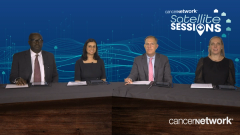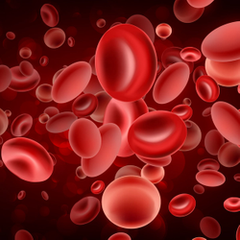
Multiple Myeloma: Data on Outcomes Based On Cytogenetics
Key opinion leaders in the field of multiple myeloma review data looking at patient outcomes in the GRIFFIN and MASTER trials based on cytogenetic abnormalities.
Episodes in this series

Transcript:
Peter Voorhees, MD: Going back to the GRIFFIN study [NCT02874742], so there was a presentation at ASH that we presented looking at outcomes in the GRIFFIN study, as well as the MASTER study [NCT03224507], based on cytogenetic abnormalities. The MASTER study…was a single-arm, phase 2 study that looked at daratumumab, carfilzomib, len[alidomide], dex[amethasone] [Dara-KRd] for transplant-eligible patients with newly diagnosed myeloma. They got 4 cycles of 4-drug induction. They got a transplant. They could potentially go on to receive two 4-cycle cassettes of Dara-KRd and then eventually go on to len maintenance. And what’s really neat about this particular trial, if you had 2 consecutive MRD [minimal residual disease]-negative readouts, you could potentially come off of therapy altogether. There are some patients who got 4 cycles of Dara-KRd, a transplant, had 2 MRD negative, and came off treatment. So, a relatively short duration of therapy. Whereas with GRIFFIN, we used Dara-RVd [daratumumab, lenalidomide, bortezomib, dexamethasone] induction, transplant, 2 cycles of Dara-RVd, consolidation and then dara-len maintenance for 2 years, and then they continued on len indefinitely as long as they were tolerating. They’re 2 very different treatment approaches, but both using a quadruplet in the induction setting.
What we showed with this particular analysis is that if you look at patients who have no high-risk cytogenetic features or 1, they did exactly the same. Whether you’re looking at GRIFFIN or MASTER, they did exactly the same. When you looked at the 2 different studies, the PFS curves were virtually superimposable. However, when you looked at those patients who had 2 high-risk cytogenetic abnormalities or, what we’ve stolen from the lymphoma community, we’re calling double-hit myeloma these days, those patients did not fare as well from a progression-free-survival perspective. So, that’s definitely an area of unmet need. Any thoughts on that data set, Reed?
Reed Friend, MD: I just wrote that question down as an unmet need, actually, to bring up later on. I have a high-risk patient who is currently on study with KRdD and was asking the question, if I’m MRD negative, does this mean I can come off therapy? And we discussed a little bit about her high-risk FISH [fluorescence in situ hybridization results] and that it wouldn’t really be wise based on that.
Peter Voorhees, MD: Yeah. I think what’s perhaps the most interesting thing about this particular analysis is that the PFS curves are so similar between GRIFFIN and MASTER, but one used a noncontinuous treatment paradigm and the other one used a more continuous treatment paradigm. And the follow-up in the MASTER trial is shorter than that of the GRIFFIN, so it’s going to be important to see how this plays out over time. But if those patients who have zero or 1 high-risk cytogenetic abnormality do just as well for a defined duration of treatment, that does beg the question, do we really need to be treating these patients continuously over the course of time? There are randomized studies that are specifically addressing that issue.
Peter Voorhees, MD: Going back to high-risk abnormalities, does high-risk cytogenetics—and when I say high-risk cytogenetics, I’m talking about deletion 1p, gain or amplification of 1q21, deletion 17p, 4;14, 14;16 translocations, etc—does that influence the way that you approach treatment of your patients with newly diagnosed myeloma?
Kwabena Osei-Boateng, MD: Two things. Sometimes I tend to, if there are patients who would tolerate carfilzomib, that might be something I would use in terms of if they don’t have any comorbidities, so sometimes it does. And then…like Amy said, I tend to send them up front for a discussion about transplant because, even if they have standard risk, they’re going to get transplant. But sometimes I like to get the opinion of the LCI [Levine Cancer Institute] myeloma team starting up front, knowing that they’re high risk. Potentially, there might be clinical trials, especially if they’re ultrahigh risk. So, that might influence how I treat them.
Peter Voorhees, MD: Yes. That’s a good point.
Transcript is AI-generated and edited for clarity and readability.
Newsletter
Stay up to date on recent advances in the multidisciplinary approach to cancer.























































































